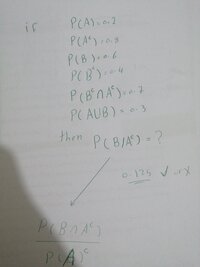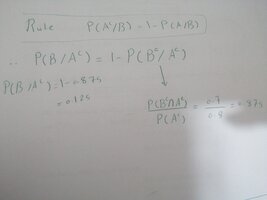You are using an out of date browser. It may not display this or other websites correctly.
You should upgrade or use an alternative browser.
You should upgrade or use an alternative browser.
probabilities: I solved it 2 different ways; it's 0.125 but in book they wrote 0.25
- Thread starter Barbra
- Start date
Dr.Peterson
Elite Member
- Joined
- Nov 12, 2017
- Messages
- 16,615
Please show us the problem and answer in the book, preferably as an image.I solved it with 2 different ways and it is 0.125 but in the book they wrote it 0.25
And also show us what you find for P(A∩B). I find it very interesting.
My suspicion is that someone has misstated the problem.
Please show us the problem and answer in the book, preferably as an image.
And also show us what you find for P(A∩B). I find it very interesting.
My suspicion is that someone has misstated the problem.
We can find P(A∩B) by knowing P(AUB)
0.3=0.2+0.6-P(A∩B)
So it's 0.5
The book didn't answered it.. It just wrote the final number.. And maybe it's Typo
Dr.Peterson
Elite Member
- Joined
- Nov 12, 2017
- Messages
- 16,615
Really? I get -0.5, which is of course impossible! So the problem doesn't make sense.We can find P(A∩B) by knowing P(AUB)
0.3=0.2+0.6-P(A∩B)
So it's 0.5
But you said,The book didn't answered it.. It just wrote the final number.. And maybe it's Typo
I call the number an answer; I suppose what you mean is that they don't give a full solution. But that isn't what I asked for.I solved it with 2 different ways and it is 0.125 but in the book they wrote it 0.25
It seems most likely to be the solution to a different problem than what you are doing. That's why I want to see the actual problem you are solving.
Please show us the problem and answer in the book, preferably as an image.
And also show us what you find for P(A∩B). I find it very interesting.
My suspicion is that someone has misstated the problem.
Attachments
I mean they didn't wrote the way of solving or the Steps.. They wrote the final answer only 0.25Really? I get -0.5, which is of course impossible! So the problem doesn't make sense.
But you said,
I call the number an answer; I suppose what you mean is that they don't give a full solution. But that isn't what I asked for.
It seems most likely to be the solution to a different problem than what you are doing. That's why I want to see the actual problem you are solving.
How did you get - 0.5?Really? I get -0.5, which is of course impossible! So the problem doesn't make sense.
But you said,
I call the number an answer; I suppose what you mean is that they don't give a full solution. But that isn't what I asked for.
It seems most likely to be the solution to a different problem than what you are doing. That's why I want to see the actual problem you are solving.
Dr.Peterson
Elite Member
- Joined
- Nov 12, 2017
- Messages
- 16,615
Again, here is what I asked for:
Please show an image of the problem itself in the book, so we can be sure what you are solving.Please show us the problem and answer in the book, preferably as an image.
And also show us what you find for P(A∩B). I find it very interesting.
My suspicion is that someone has misstated the problem.
Really? I get -0.5, which is of course impossible! So the problem doesn't make sense.
But you said,
I call the number an answer; I suppose what you mean is that they don't give a full solution. But that isn't what I asked for.
It seems most likely to be the solution to a different problem than what you are doing. That's why I want to see the actual problem you are solving.
The book is in Arabic Unfortunately..
Can you please try to solve this problem, i said maybe 0.25 is wrong but we want to solve the problem and to get the correct answers, so can you please show to me how to solve it and to get the right answer?
Dr.Peterson
Elite Member
- Joined
- Nov 12, 2017
- Messages
- 16,615
Please take the time to think; you have been responding too quickly. Can you see how I got that? Try!How did you get - 0.5?
I don't care if it's in Arabic. We may still be able to see what is going on if you show it to us. (And maybe some of us understand Arabic?) But please also give us a translation of the problem itself, as exactly as possible.The book is in Arabic Unfortunately..
You seem to be missing the point. The problem is invalid! It is impossible for P(A) + P(B) to be greater than P(A∪B).Can you please try to solve this problem, i said maybe 0.25 is wrong but we want to solve the problem and to get the correct answers, so can you please show to me how to solve it and to get the right answer?
Your answer is "correct", as far as any answer can be; but they presumably answered another, valid question, which would be why their answer is different.
If you copied everything correctly, then they have printed it incorrectly, so it isn't worth trying to solve.
Dr.Peterson
Elite Member
- Joined
- Nov 12, 2017
- Messages
- 16,615
@Barbra: I just realized I asked the wrong question here. Yes, P(A∩B) = 0.5; but P(A∩Bc) = P(A) - P(A∩B) = 0.2 - 0.5 = -0.3. (I misread my Venn diagram.) What's impossible in the statement of the problem is for P(A∪B) to be less than P(B). I'm sorry for the mistake.And also show us what you find for P(A∩B). I find it very interesting.
My suspicion is that someone has misstated the problem.
(But it isn't clear exactly which facts are given, since you stated six redundant facts, so I can't be sure where a mistake was made.)


